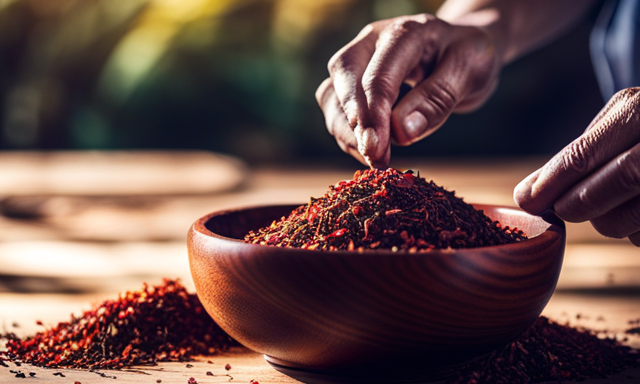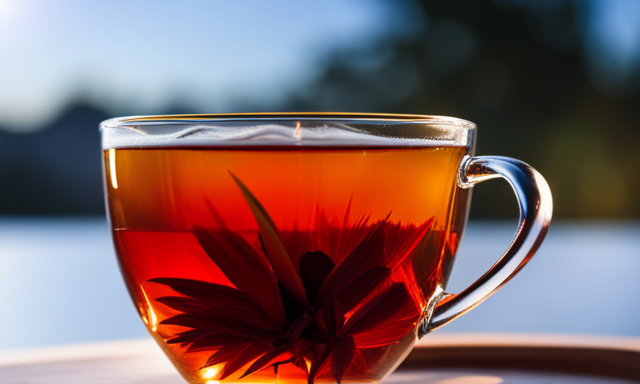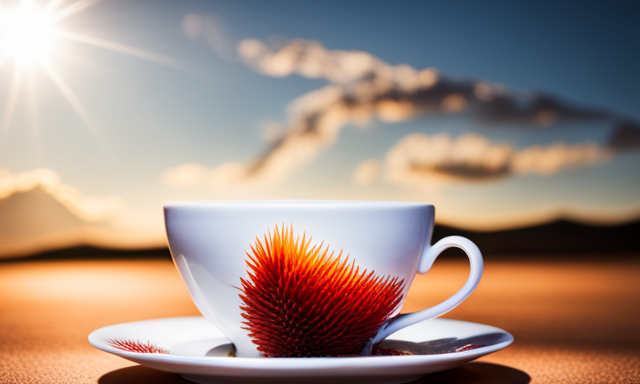Have you ever wanted to create your very own blend of rooibos tea? Well, get ready to embark on a delightful journey of flavor exploration! Making a rooibos tea blend is like being a master chef in your own tea laboratory, carefully crafting a symphony of tastes that will tantalize your taste buds. With a dash of creativity and a pinch of curiosity, you can create a tea blend that is uniquely yours.
In this article, I will guide you through the process of making a rooibos tea blend step by step. We will start by familiarizing ourselves with the different types of rooibos tea available, selecting a base tea that suits our preferences, and gathering the perfect ingredients for flavoring.
Then, we will determine the ideal ratio of base tea to flavorings, prepare our flavorings with precision, and let our blend rest to allow the flavors to meld together harmoniously. Finally, we will taste and adjust our blend until it reaches perfection, store it properly, and enjoy the fruits of our labor.
So, grab your tea leaves and let’s get blending!
Key Takeaways
- Experiment with different flavorings and proportions to create unique combinations.
- Follow the brewing process to ensure optimal color, aroma, and taste.
- Consider adding cinnamon, nutmeg, ginger, dried lavender, chamomile, or other spices and herbs for flavor variation.
- Store the rooibos tea blend properly in an airtight container away from direct sunlight to maintain flavor and potency.
Familiarize Yourself with Different Types of Rooibos Tea
Familiarize yourself with the different types of rooibos tea, so you can envision the variety of flavors and colors available.
Rooibos tea, also known as red bush tea, comes in various forms, each offering a unique taste and aroma. There are green rooibos, which is unfermented and has a lighter flavor, and red rooibos, which is fermented and has a richer, sweeter taste.
Additionally, there are flavored rooibos teas, such as vanilla, honeybush, and citrus-infused blends, which add a delightful twist to the traditional rooibos flavor.
Different brewing methods can be used to bring out the best in each type of rooibos tea.
Aside from its delicious taste, rooibos tea also offers numerous health benefits and uses, such as promoting relaxation, aiding digestion, and boosting the immune system.
Once you’re familiar with the different types, it’s time to select your base rooibos tea and start experimenting with your own unique blend.
Select Your Base Rooibos Tea
Firstly, let’s choose the perfect base for our delectable rooibos blend – which rich and aromatic variety will entice our taste buds? There are several different varieties of rooibos tea to try, each offering its own unique flavor profile and health benefits. To help you decide, here’s a table showcasing some popular options:
| Variety | Flavor Profile | Health Benefits |
|---|---|---|
| Green Rooibos | Light and grassy | High in antioxidants, aids digestion |
| Red Rooibos | Sweet and nutty | Rich in minerals, promotes healthy skin |
| Honeybush Rooibos | Sweet and fruity | Boosts the immune system, relieves allergies |
| Vanilla Rooibos | Creamy and smooth | Calms the nervous system, aids in relaxation |
Now that we have our base options, let’s move on to the next step and gather our ingredients for flavoring.
Gather Your Ingredients for Flavoring
Let’s start by rounding up all the ingredients we’ll need to add some delectable flavors to our rooibos concoction. Here are three different flavorings for rooibos tea that’ll take your brew to the next level:
-
Fruity Twist: Gather dried fruits like berries, apples, or citrus peels. These’ll infuse your tea with a refreshing burst of natural sweetness.
-
Herbal Infusion: Collect a variety of herbs such as mint leaves, chamomile, or lavender. These herbs not only add depth of flavor but also provide numerous health benefits.
-
Spiced Delight: Spice things up by including ingredients like cinnamon sticks, cloves, or ginger. These warming spices’ll give your rooibos tea a cozy and comforting taste.
Rooibos tea itself offers a range of health benefits, including its rich antioxidants and potential to improve heart health. Now that we’ve got our flavorings ready, let’s move on to determining the ratio of base tea to flavorings.
Determine the Ratio of Base Tea to Flavorings
Once you’ve gathered your flavorful ingredients, it’s time to strike the perfect balance between the base tea and the flavorings in your rooibos concoction. Determining the ratio of base tea to flavorings is crucial in creating a well-rounded and enjoyable blend. To guide you in this process, consider using a 2 column and 4 row table to keep track of your experiments. In one column, list the different flavor combinations you’re exploring, such as vanilla and almond or citrus and ginger. In the other column, note the corresponding ratios of base tea to flavorings you use for each combination. This will help you determine the ideal steeping time and the amount of flavorings needed to achieve a harmonious and flavorful blend. With this information, you can move on to the next step of preparing your flavorings.
Prepare Your Flavorings
To prepare your flavorings, start by gathering the ingredients that’ll enhance the taste and aroma of your rooibos blend. Experiment with different flavor combinations to create a unique and delicious tea. Consider using natural flavorings like dried fruits, herbs, and spices to infuse your rooibos tea with flavor. Dried citrus peels can add a refreshing tang, while vanilla beans can lend a sweet and creamy undertone. You can also try adding floral notes with lavender or rose petals. Natural flavorings not only enhance the taste but also provide additional health benefits, as they’re free from artificial additives.
Now that you’ve prepared your flavorings, it’s time to blend your rooibos tea and create a delightful cup of goodness.
Blend Your Rooibos Tea
Now that you’ve gathered your flavorings, it’s time to infuse your rooibos tea with a symphony of tantalizing tastes and aromatic notes, creating a harmonious blend that will transport your senses to a world of pure delight.
Rooibos tea is incredibly versatile, allowing you to experiment with different flavors to suit your taste preferences. Whether you choose to add fruits like citrus or berries, spices like cinnamon or ginger, or even herbs like mint or lavender, the possibilities are endless.
Not only will your taste buds thank you, but your body will too. Rooibos tea is known for its numerous health benefits, including its rich antioxidant content, ability to promote digestion, and potential to boost the immune system.
So go ahead, get creative with your blend and enjoy the journey of discovering the perfect combination of flavors that will enhance both your tea-drinking experience and your well-being.
Now, let the blend rest, allowing the flavors to meld together and create a truly remarkable cup of rooibos tea.
Let the Blend Rest
Allow the tantalizing flavors of your rooibos tea blend to harmonize and develop their full potential by giving it the time it needs to rest and infuse.
After you’ve blended the ingredients, it’s important to let the tea rest for a period of time. This resting period allows the flavors to meld together, creating a more complex and well-rounded taste. Additionally, the resting period allows the tea leaves to fully absorb the flavors of any added ingredients, such as fruits or spices.
The benefits of resting your rooibos tea blend are numerous. It allows the flavors to deepen and intensify, resulting in a more satisfying and flavorful cup of tea. So, be patient and give your blend the time it needs to rest and infuse.
Once the resting period is over, it’s time to move on to the next step: taste and adjust.
Taste and Adjust
When taste testing a rooibos tea blend, it’s important to start by brewing a small amount of the blend for sampling. This allows you to get a sense of the flavors and adjust accordingly.
If the blend lacks flavor, you can add more flavorings such as herbs, fruits, or spices. On the other hand, if the blend is too strong, you can add more of the base tea to balance it out.
It’s all about finding the perfect balance of flavors to create a delicious and satisfying rooibos tea blend.
Brew a Small Amount of the Blend for Sampling
To get a taste of your rooibos tea blend, start by brewing a small amount for sampling. This will allow you to experiment with different sampling techniques and flavoring combinations. To do this, measure out a small quantity of your rooibos tea blend and place it in a teapot or infuser. Add hot water at the recommended temperature and let it steep for the suggested time. Once brewed, pour the tea into a cup and take note of the color, aroma, and taste. Use a table to record your observations, noting down the different flavorings used and their proportions. This sampling process will help you determine if any adjustments are needed, such as adding more flavorings or base tea as needed.
Add More Flavorings or Base Tea as Needed
After brewing a small amount of the blend for sampling, I realized that it lacked a certain depth of flavor. To enhance the taste, I decided to add more flavorings and experiment with different herbs.
I started by adding a pinch of cinnamon and a dash of nutmeg to infuse the rooibos tea with warm and comforting notes. Additionally, I tried incorporating a hint of ginger for a subtle kick. These additional spices elevated the flavor profile and created a more well-rounded blend.
To further explore the possibilities, I decided to venture into the realm of herbs. I experimented with dried lavender and chamomile, which brought a soothing and floral element to the tea.
The possibilities are endless, and I encourage you to add more spices and try different herbs to create your own unique rooibos tea blend.
Now, let’s move on to the next section about how to store and enjoy your creation.
Store and Enjoy
Savor the rich flavors of your homemade rooibos tea blend as you relax and unwind. Once you have prepared and steeped your blend to perfection, it’s time to store it properly to maintain its freshness and preserve its health benefits. It is important to store your rooibos tea blend in an airtight container away from direct sunlight and at room temperature, around 68-77°F (20-25°C). This will help to maintain the flavor and potency of the tea.
To evoke a sense of warmth and comfort, imagine yourself cozying up with a cup of rooibos tea while a gentle rain taps against the windowpane. Take a moment to enjoy the aromas and flavors that you have carefully curated.
As you experiment and share your homemade rooibos tea blend, you will discover new and exciting combinations that suit your personal preferences. So go ahead, explore, and find your perfect cup of rooibos tea.
Experiment and Share
Indulge in the joy of experimenting with different flavors and combinations as you share the delightful experience of your homemade rooibos tea blend with loved ones.
The beauty of making your own blend is the endless possibilities it offers. You can add different herbs, fruits, or spices to create unique flavors that suit your taste. Experimentation benefits not only your palate but also your health. For example, adding ginger can provide a spicy kick and aid digestion, while adding lavender can promote relaxation.
Sharing your experiences with others is a fantastic way to inspire creativity and bond over a shared passion for tea. By sharing your recipe and the stories behind it, you can create lasting memories and foster a sense of community.
So, don’t be afraid to get creative and share the joy of your rooibos tea blend with others.
Frequently Asked Questions
How long should I let the blend rest before tasting and adjusting?
For the best results, I suggest letting the rooibos tea blend rest for at least 24 hours before tasting and adjusting. This allows the flavors to fully develop. To store it properly, keep it in an airtight container away from sunlight and moisture.
Can I use any type of rooibos tea as a base for my blend?
Oh, you betcha! When it comes to choosing a rooibos tea base for blending, you gotta consider factors like flavor profile, caffeine content, and quality. Different types of rooibos teas offer unique characteristics to bring to your blend.
Are there any specific ingredients that I should avoid when flavoring my rooibos tea blend?
To enhance the flavor of a rooibos tea blend without using specific ingredients, it’s important to avoid certain additives. Steer clear of artificial sweeteners, flavorings, and additives, as these can overpower the natural taste of rooibos tea.
How long can I store my rooibos tea blend and still enjoy its flavor?
To maintain the flavor of your rooibos tea blend, proper storage methods are crucial. Store it in an airtight container away from light, heat, and moisture. Follow these best practices for long-lasting freshness.
What are some popular flavor combinations for rooibos tea blends that I can experiment with?
Popular flavor combinations for rooibos tea blends include citrus fruits like orange or lemon, spices like cinnamon or ginger, and floral additions like lavender or rose petals. These combinations not only enhance the taste but also provide the numerous health benefits of drinking rooibos tea.
Conclusion
In conclusion, making your own rooibos tea blend can be a fun and creative process. By familiarizing yourself with different types of rooibos tea and selecting a base tea that suits your taste, you can create a blend that’s truly unique.
Experimenting with different flavorings and ratios will allow you to customize your blend to perfection. Did you know that rooibos tea is naturally caffeine-free and rich in antioxidants? This makes it a healthy and delicious choice for tea lovers.
So go ahead, get creative, and enjoy the art of blending your own rooibos tea!










